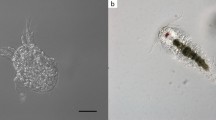Abstract
Conidia of the entomopathogenic fungus Metarhizium anisopliae (Ascomycota: Clavicipitaceae) were assessed against Rhipicephalus sanguineus (Arachnida: Ixodidae) eggs under laboratory conditions. Clusters of 25 eggs were applied either directly with the fungal conidial formulations or set on previously fungus-treated filter paper. Treatments consisted of conidia formulated in water or an oil-in-water emulsion at final concentrations of 3.3 × 103, 104, 3.3 × 104, 105, or 3.3 × 105 conidia/cm2. The development of mycelium and new conidia on egg clusters incubated at 25 °C and humidity close to saturation depended on conidial concentration, formulation, and application technique. No larvae eclosed from eggs after direct applications of conidia regardless of the formulation. The eclosion and survival of larvae from indirectly treated egg clusters depended on the type of formulation and conidial concentration applied. Oil-in-water formulations of conidia demonstrated the highest activity against eggs of R. sanguineus.




Similar content being viewed by others
References
Alves RT, Bateman RP, Prior C, Leather SR (1998) Effects of simulated solar radiation on conidial germination of Metarhizium anisopliae in different formulations. Crop Prot 17:675–679
Braga GUL, Flint SD, Miller CD, Anderson AJ, Roberts DW (2001) Both solar UVA and UVB radiation impair conidial culturability and delay germination in the entomopathogenic fungus Metarhizium anisopliae. Photochem Photobiol 74:734–739
D´Alessandro WB, Rodrigues J, Fernandes ÉKK, Luz C (2014) Impact of humidity on clustered tick eggs. Parasitol Res 113:3899–3902
Dantas-Torres F (2008) The brown dog tick, Rhipicephalus sanguineus (Latreille, 1806) (Acari: Ixodidae): From taxonomy to control. Vet Parasitol 152:173–185
Dantas-Torres F (2010) Biology and ecology of the brown dog tick, Rhipicephalus sanguineus. Parasite Vector 3:26
Fargues J, Goettel MS, Smits N, Ouedraogo A, Vidal C, Lacey LA, Lomer CJ, Rougier M (1996) Variability in susceptibility to simulated sunlight of conidia among isolates of entomopathogenic Hyphomycetes. Mycopathologia 135:171–181
Fernandes ÉKK, Bittencourt VREP (2008) Entomopathogenic fungi against South American tick species. Exp Appl Acarol 46:71–93
Garcia MV, Monteiro AC, Szabo MJP, Prette N, Bechara GH (2005) Mechanism of infection and colonization of Rhipicephalus sanguineus eggs by Metarhizium anisopliae as revealed by scanning electron microscopy and histopathology. Braz J Microbiol 36:368–372
Garcia MV, Monteiro AC, Szabó MPJ, Prette N (2008) Eventos externos e internos da infecção de larvas e ninfas de Rhipicephalus sanguineus por Metarhizium anisopliae. Arq Bras Med Vet Zootec 60:855–863
Gindin G, Ment D, Rot A, Glazer I, Samish M (2009) Pathogenicity of Metarhizium anisopliae (Hypocreales: Clavicipitaceae) to tick eggs and the effect of egg cuticular lipids on conidia development. J Med Entomol 46:531–538
Hedimbi M, Kaaya GP, Singh S, Chimwamurombe PM, Gindin G, Glazer I, Samish M (2008) Protection of Metarhizium anisopliae conidia from ultra-violet radiation and their pathogenicity to Rhipicephalus evertsi evertsi ticks. Exp Appl Acarol 46:149–156
Kaaya GP, Samish M, Hedimbi M, Gindin G, Glazer I (2011) Control of tick populations by spraying Metarhizium anisopliae conidia on cattle under field conditions. Exp Appl Acarol 55:273–281
Luz C, Tai MHH, Santos AH, Rocha LFN, Albernaz DAS, Silva HHG (2007) Ovicidal activity of entomopathogenic Hyphomycetes on Aedes aegypti (Diptera: Culicidae) under laboratory conditions. J Med Entomol 44:799–804
Ment D, Gindin G, Glazer I, Perl S, Elad D, Samish M (2010) The effect of temperature and relative humidity on the formation of Metarhizium anisopliae chlamydospores in tick eggs. Fung Biol 114:49–56
Nchu F, Maniania NK, Hassanali A, Eloff KN (2010) Optimizing modes of inoculation of Rhipicephalus ticks (Acari: Ixodidae) with a mitosporic entomopathogenic fungus in the laboratory. Exp Appl Acarol 51:373–382
Parola P, Paddock CD, Raoult D (2005) Tick-borne rickettsioses around the world: emerging diseases challenging old concepts. Clin Microbiol Rev 18:719–756
Rocha LFN, Inglis PW, Humber RA, Kipnis A, Luz C (2013) Occurrence of Metarhizium spp. in Central Brazilian soils. J Basic Microbiol 53:251–259
Samish M, Rot A, Ment D, Barel S, Glazer I, Gindin G (2014) Efficacy of the entomopathogenic fungus Metarhizium brunneum in controlling the tick Rhipicephalus annulatus under field conditions. Vet Parasitol 206:258–266
Throne JE, Weaker DK, Chew V, Baker JE (1995) Probit analysis of correlated data: multiple observations over time at one concentration. J Econ Entomol 88:1510–1512
Acknowledgments
The authors thank the National Council of Scientific and Technological Development (CNPq, Brazil) for financial support, Center of Control of Zoonosis (CCZ) in Goiânia (Goiás, Brazil) for providing material, and Richard A Humber (USDA-ARS, Ithaca, NY, USA) for the critical review of the manuscript.
Author information
Authors and Affiliations
Corresponding author
Rights and permissions
About this article
Cite this article
Luz, C., D’Alessandro, W.B., Rodrigues, J. et al. Efficacy of water- and oil-in-water-formulated Metarhizium anisopliae in Rhipicephalus sanguineus eggs and eclosing larvae. Parasitol Res 115, 143–149 (2016). https://doi.org/10.1007/s00436-015-4729-z
Received:
Accepted:
Published:
Issue Date:
DOI: https://doi.org/10.1007/s00436-015-4729-z



